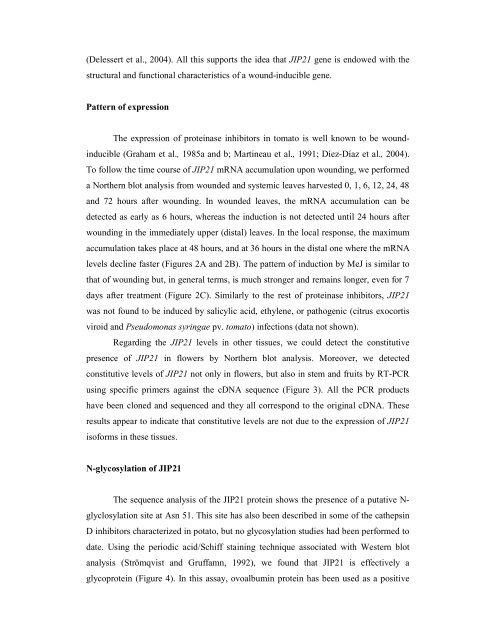Tomato CDI as a Strong Chymotrypsin Inhibitor ... - Plant Physiology
Tomato CDI as a Strong Chymotrypsin Inhibitor ... - Plant Physiology
Tomato CDI as a Strong Chymotrypsin Inhibitor ... - Plant Physiology
Create successful ePaper yourself
Turn your PDF publications into a flip-book with our unique Google optimized e-Paper software.
(Delessert et al., 2004). All this supports the idea that JIP21 gene is endowed with the<br />
structural and functional characteristics of a wound-inducible gene.<br />
Pattern of expression<br />
The expression of protein<strong>as</strong>e inhibitors in tomato is well known to be woundinducible<br />
(Graham et al., 1985a and b; Martineau et al., 1991; Díez-Díaz et al., 2004).<br />
To follow the time course of JIP21 mRNA accumulation upon wounding, we performed<br />
a Northern blot analysis from wounded and systemic leaves harvested 0, 1, 6, 12, 24, 48<br />
and 72 hours after wounding. In wounded leaves, the mRNA accumulation can be<br />
detected <strong>as</strong> early <strong>as</strong> 6 hours, where<strong>as</strong> the induction is not detected until 24 hours after<br />
wounding in the immediately upper (distal) leaves. In the local response, the maximum<br />
accumulation takes place at 48 hours, and at 36 hours in the distal one where the mRNA<br />
levels decline f<strong>as</strong>ter (Figures 2A and 2B). The pattern of induction by MeJ is similar to<br />
that of wounding but, in general terms, is much stronger and remains longer, even for 7<br />
days after treatment (Figure 2C). Similarly to the rest of protein<strong>as</strong>e inhibitors, JIP21<br />
w<strong>as</strong> not found to be induced by salicylic acid, ethylene, or pathogenic (citrus exocortis<br />
viroid and Pseudomon<strong>as</strong> syringae pv. tomato) infections (data not shown).<br />
Regarding the JIP21 levels in other tissues, we could detect the constitutive<br />
presence of JIP21 in flowers by Northern blot analysis. Moreover, we detected<br />
constitutive levels of JIP21 not only in flowers, but also in stem and fruits by RT-PCR<br />
using specific primers against the cDNA sequence (Figure 3). All the PCR products<br />
have been cloned and sequenced and they all correspond to the original cDNA. These<br />
results appear to indicate that constitutive levels are not due to the expression of JIP21<br />
isoforms in these tissues.<br />
N-glycosylation of JIP21<br />
The sequence analysis of the JIP21 protein shows the presence of a putative Nglyclosylation<br />
site at Asn 51. This site h<strong>as</strong> also been described in some of the cathepsin<br />
D inhibitors characterized in potato, but no glycosylation studies had been performed to<br />
date. Using the periodic acid/Schiff staining technique <strong>as</strong>sociated with Western blot<br />
analysis (Strömqvist and Gruffamn, 1992), we found that JIP21 is effectively a<br />
glycoprotein (Figure 4). In this <strong>as</strong>say, ovoalbumin protein h<strong>as</strong> been used <strong>as</strong> a positive

















